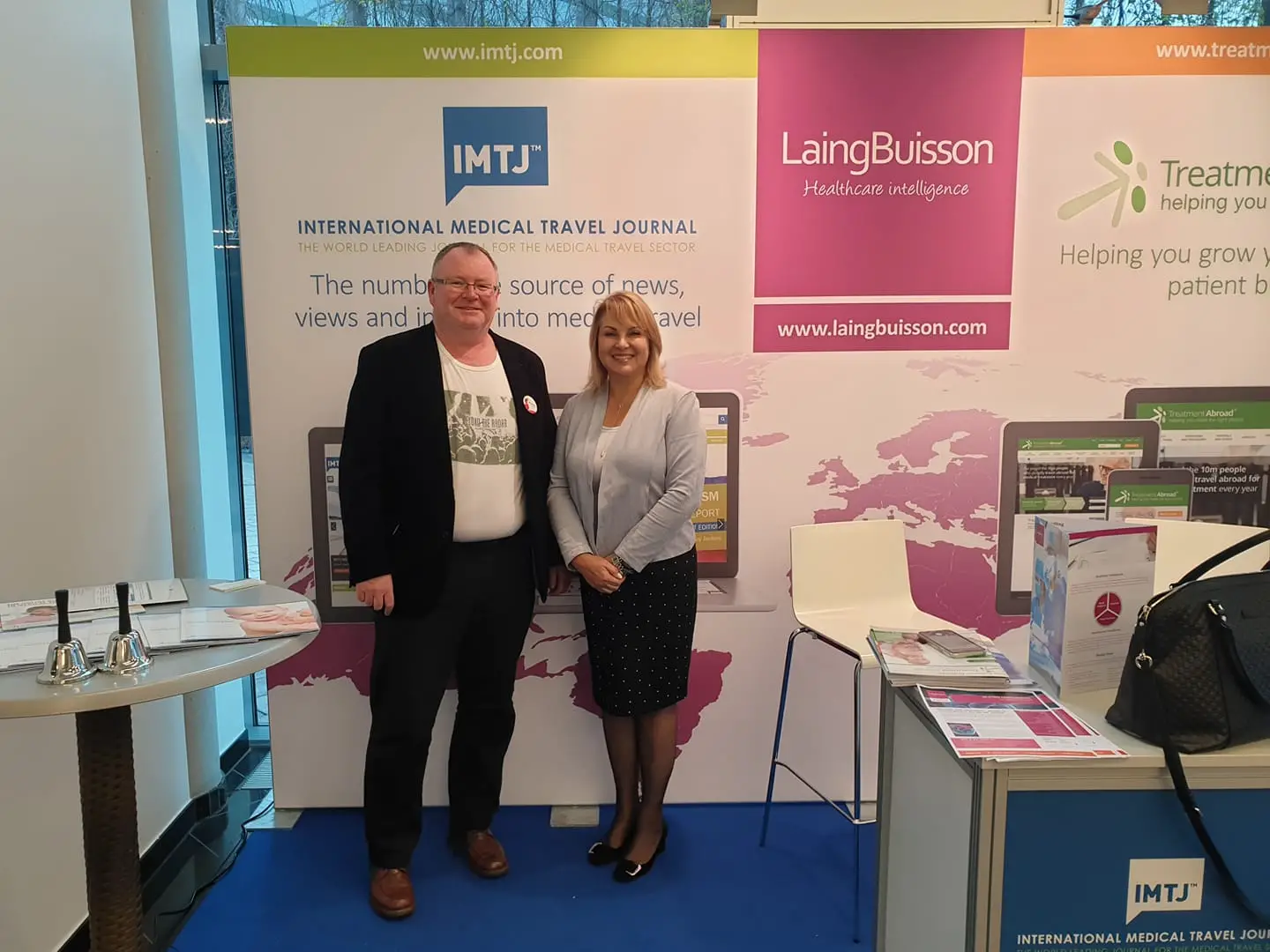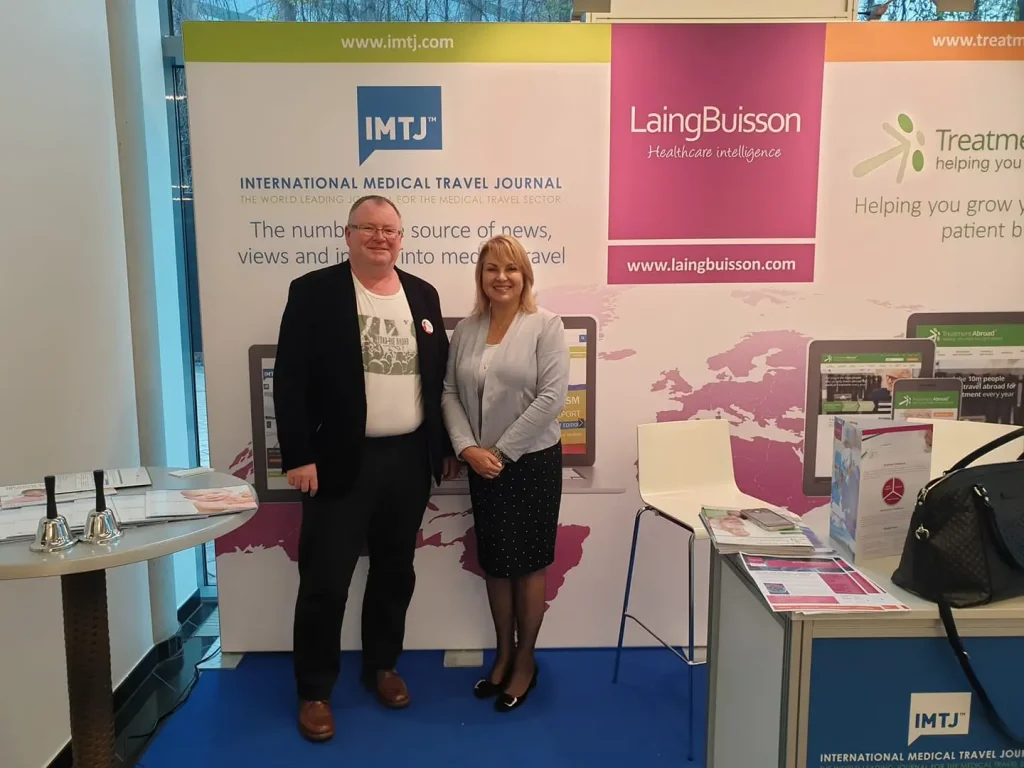
December 8, 2019 – TCN caught up with Inna Bergman, CEO and founder of RTMC Medical, at IMTJ 2019 in Berlin to learn the fascinating history of the Israeli medical tourism industry.
TCN was in Berlin earlier this week at the medical tourism ‘Oscars’, IMTJ 2019, where Bagatin Clinic did Croatia proud by winning International Cosmetic Surgery Clinic of the Year. But it was also a chance to mix and mingle with the movers and shakers of medical tourism in other countries, including Israel. I am very grateful to Inna Bergman, icon of the Israeli medical tourism industry, for taking time in her busy schedule for an hour-long interview with TCN on the origins and growth of the medical tourism industry in Israel – it is a fascinating story.
Tell us firstly about the origins of the Israeli medical tourism story. When did it start?
Although medical tourism has only been officially recognised as an industry with the appropriate regulation in the last decade or so, it has been an established thing for much longer. Its origins date back to the 1960s, when private Arab planes from the Gulf states and other neighbouring countries would touch down at Ben Gurion Airport for treatment. In such cases, there were no issues with paperwork or visas. It was a practical arrangement. This continued up until the Yom Kippur war in 1973. The main medical reasons were oncology and specific surgeries.
Medical tourism from Arab countries began once more in the early 1980s with peace agreements with Jordan and Egypt, whose patients travelled to Israel for treatment. And then, in the early 1990s, came the biggest wave of patients – from the former Soviet Union, a market which today still accounts for about 70% of Israel’s medical tourism industry.
The collapse of the Soviet Union allowed former Soviet subjects to travel, as well as to travel for medical treatment. Israel became a very popular destination at a time when many Soviet Jews were also emigrating to Israel. In just a few years, some 1.3 million Soviet Jews emigrated, and there was such a population shift in Israel that 25% of the country’s citizens now spoke Russian, Ukranian and other ex-Soviet languages.
There were Russian supermarkets, restaurants and other facilities, and many Russians who needed treatment had Jewish friends who had moved to Israel. This meant that in addition to the excellent reputation of Israeli doctors, there was something familiar about coming to Israel – it was more like Russia in the Sun. Israel had a strong reputation for medical excellence, for new medical protocols and technology, but also for its mobile doctors who went abroad for fellowships to Europe and the USA. This helped to develop a network and image of Israel as an exceptional medical destination. The numbers grew rapidly, with the main reasons for travel related to oncology, cardiology, radiology, rehabilitation, and diabetes.
It was a crazy time, for it all just happened, and there was no system in place to deal with this influx. There was no Internet, mobile phones, credit cards, and patients struggled with basic things such as transferring money from Russia. It really was the Dark Ages, and few people remember it today, but we did what we had to do. I was a nurse in a big government organisation with an MBA in administration in hospital and case management. We simply learned as we went along, from helping patients doing the laundry to being there through the whole procedure. The term ‘medical tourism’ was still not known – they were simply patients who needed our help.
Other countries joined the market, for example Germany in 1995, and that ate into our market share, but the lack of visa requirement has been a big selling point for Russia. Cyprus, for example, used to be a big destination for Russians until the EU visa requirement came in.
And our international patients found a country very different to the one many envisaged. They came expecting to see camels in the desert and found instead a highly sophisticated Israel. The peak years of medical tourism in Israel were 2012 – 2015 before the Russian economy declined. At that point, about 40,000 patents were coming, but not for a few days, but for weeks, months, even a year in the case of a child oncology patient. When they left, many of them had become part-Israeli.
The market is still dominated by the ex-Soviet countries (70%), but new markets are now evolving, particularly in China and Africa – countries such as Ivory Coast and Nigeria. Where previously, richer African patients might have gone to Germany or the former colonial capitals of London or Paris, more and more are looking to Israel. Israel has a reputation as a hi-tech destination, one which is being fostered around the world by Israeli tech companies being very active internationally. it is opening new markets for Israel for medical tourism.
What are the main types of treatment patients travel to Israel for?
About half of our patients come for oncology. Some patients sadly leave things too late. If they had come a little earlier, they would have much better results, in some cases a full recovery. About 30% come for specific surgeries – spine and orthopedic trauma, while 20% come for general diagnostics and second opinions. People are losing faith in the opinions of local doctors and often come to us for a full check-up.
Technology is changing things, and there is a new niche in the industry – second opinion consultations online. Technology can now make MRI and CT scans available anywhere in the world, and Israeli doctors now deal with many patients from Europe, China and the USA for advice and a second opinion. The advance of technology allows for accurate recommendations from our doctors.
It sounds that the medical tourism industry in Israel is a lot more structured these days after that chaotic start. Tell us a little more about that.
For a long time, nobody collected statistics or even saw the potential of medical tourism or that it was anything more than a sporadic thing. the ministry started to get involved in the mid-1990s, and only in the last ten years has it formalised things. All the medical tourism goes through hospitals and now it is highly regulated. Investment is happening from the ministries of tourism, health and economy, as well as insurance and facilitator companies.
Since January 2018, all facilitators have been highly regulated, in addition to the hospitals. They must register with the Ministry of Health and adhere to a strict code fo ethics. As a result, many smaller companies have disappeared from the market. You cannot do medical tourism effectively without certification and standardisation. There was a high-profile case a few years ago of a facilitator who took money from a Russian patient, did not meet him at the airport and just disappeared. Such things can destroy a reputation, and they are no longer possible due to the high regulation. Hospitals are not free to do what they want with medical tourism, they can only do what the Ministry of Health allows. The ministry regulates, for example, how patients are received, invitations, the treatment plan, and who will meet and treat the patient.
Is there any negative backlash that foreign patients are taking Israeli hospital beds?
Yes, we have had these situations, but mostly this is a matter of politics rather than an actual problem. If you look at the real numbers in an intelligent manner, you will understand that this is not an issue. A mid-size hospital, for example, will see 150,000 Isreali patients a year. The same hospital will see about 1,500 international patients each year, about half of which are not hospitalised – they come for consultations, MRI scans, or second opinions.
I was surprised that you did not mention dental and IVF treatment in your medical tourism breakdown. I would have thought Israel would be strong and competitive in both.
Israel is very strong in dentistry, but it is mostly conducted through private practice. Due to the way that our medical tourism is structured, official medical tourism only counts if it is through hospitals, not in private practice. And so, unlike most countries in the industry, we do not count dental tourism as official medical tourism. Dental tourism from Russia in particular used to be more significant than now due to their own emerging industry, higher prices in Israel, and increased competition elsewhere.
Regarding IVF, Israel is VERY strong in this department. Indeed, in May 2012, the New York Times declared Israel the IVF capital of the world. One thing you should know is that IVF treatment is free and unlimited for Israeli citizens, covered by insurance. We had one case recently of a 45-year-old Israeli woman who gave birth to twins – a boy and a girl – after 20 unsuccessful cycles. Family and children are very important to us. Hence we have the highest number of IVF treatments in the world, some 5,000 cycles per 1 million inhabitants, a crazy number. Only now are we talking about limiting the age of the woman.
Our IVF treatments are available to international patients. Interestingly, we have a large sperm bank, and Chinese patients in particular are interested in Jewish sperm donation, as they value the strong genes which result. The government also permits highly regulated imports of egg donations, so there are many possibilities. So far this year, we have had six live Chinese babies born.
Israeli doctors are at the forefront of progress and innovations in medicine, in medical technology and pharma. Israeli doctors actively participate in various Israeli and International multicentre studies, and the number of Biotech companies in Israel is growing constantly.
Tell us about Dead Sea treatments – is this a gimmick, and is it part of your official medical tourism?
No, it is not a gimmick, and it is also not part of our official medical tourism, as it is more related to spa treatments. But we have excellent results for skin treatments, and many patients have been coming since the 1960s, often twice a year in May and November when it is not so hot. They take regular mud and salty water treatments over a period of 3-5 weeks, and the results are excellent. As this is not done via hospitals typically, it is classified more as regular tourism.
And finally – and perhaps I should have started with this – who is the incredible Inna Bergman, and what is your place in the Israeli medical tourism story?
I was born in Moscow and moved to Israel as a child just after the Yom Kippur war in 1974. I am a nurse by training and worked most of my professional life in intensive care, first in paediatrics, then in cardiac. I got a Masters degree in Boston in public administration in hospitals and case management. I am a mother of two and grandmother of five. When the international patients came in the 90s, I was managing the whole process of their stay, from arranging the doctors and consultations to their travel arrangements and laundry. I was a public servant until 2009 when I retired and opened my own clinic with my beliefs and philosophies on how all this should work.
My department was the first official medical tourism department in Israel. Nobody knew how to do things or even what to do. Back in the mid-1990s, I wrote the first regulation sheets. Now everyone works with these, but back then there was nothing. I put in a recommendation to the Ministry of Health on how to regulate the industry, and the need for accreditation for facilitators. Years went by, and I thought that my work was lost in some pile of papers on an official’s desk, but my recommendations were finally accepted and put in motion, and now we have a State law for medical tourism. I am very happy that this exciting market has gone from chaos to regulation.
Inna Bergman is the founder and CEO of RTMC Medical, and you can connect with her via the official website.
For the latest from the Croatian medical tourism industry, follow the dedicated TCN section.











